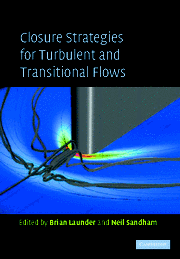6 - Modelling Heat Transfer in Near-Wall Flows
Published online by Cambridge University Press: 06 July 2010
Summary
Abstract
Recent developments in turbulence models for heat transfer are presented, focusing on near-wall behavior of thermal turbulence in flows with different Prandtl numbers. First, we outline a phenomenological two-equation heattransfer model for gaseous flows along with an accurate prediction of wall turbulent thermal fields. The model reproduces the correct wall-limiting behavior of velocity and temperature under arbitrary wall thermal conditions. The model appraisal is given with four different typical thermal fields, which often occur in engineering applications, in wall turbulent shear flows. Secondly, we describe the methodology of how to construct a rigorous two-equation heattransfer model with the aid of the most up-to-date direct numerical simulation (DNS) data for wall turbulence with heat transfer. The DNS data indicate that the near-wall profile of the dissipation rate, ϵθ, for the temperature variance, kθ (= θ2/2), is completely different from the previous model predictions. We demonstrate the results of a critical assessment of existing ϵθ equations for both two-equation and second-order closure models. Based on these assessments, we construct a new dissipation rate equation for temperature variance, taking into account all the budget terms in the exact ϵθ equation. Also, we present a similarly refined kθ equation, which is linked with this new ϵθ equation, to constitute a new two-equation heat-transfer model. Comparisons of the refined model predictions with the DNS data for a channel flow with heat transfer are given, which shows excellent agreement for the profiles of kθ and ϵθ themselves and the budget in the kθ and ϵθ equations. The only limitation is that this refined model is applicable only to gaseous flows such as air streams. Thus, finally, we present the development of a heat-transfer model for a variety of Prandtl-number fluids. This model incorporates new velocity and time scales to represent various sizes of eddies in velocity and thermal fields with different Prandtl numbers. Fundamental properties of the reconstructed kθ-ϵθ model are first verified in basic flows under arbitrary wall thermal boundary conditions and next in backward-facing-step flows at various Prandtl numbers through a comparison of the predictions with the DNS and measurements.
Introduction
The turbulence model for heat transfer is a set of differential equations which, when solved with the mean-flow and turbulence Reynolds-stress equations, allows calculations of relevant correlations and parameters that simulate the behavior of thermal turbulent flows.
- Type
- Chapter
- Information
- Closure Strategies for Turbulent and Transitional Flows , pp. 188 - 247Publisher: Cambridge University PressPrint publication year: 2002
- 5
- Cited by



